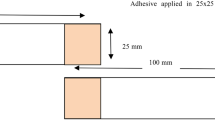Abstract
In this study, three different types of bio-based resins are compared to a conventional oil-based epoxy in terms of moisture uptake, long-term properties and its influence of moisture and glass transition temperature, T g. Moisture uptake is determined by means of gravimetric method, time temperature superposition (TTSP), and T g data obtained in dynamic mechanical thermal analysis (DMTA). Moisture uptake show Fickian diffuison behavour for all resins, saturation level and diffusion coefficient however differ. The long-term properties is characterised by creep compliance master curves created by means of TTSP. The examined bio-based resins are compatible to the reference epoxy in term of stability up to 3–10 years. Comparison between master curves for virgin, wet, and dried material show that moisture present in the specimen increases creep rate, and that some of this increase remains after drying of samples. T g measurements show that moisture inside the specimen decreases T g; this is anticipated because of the plasticizing effect of water. The overall conclusions are that the bio-based resins of polyester, and epoxy type are comparable in performance with oil-based epoxy, LY556 and they can be used to develop high-performance composites.









Similar content being viewed by others
References
White Paper 2011 (2011) Roadmap to a single European transport area: towards a competitive and resource efficient transport system. Brussels, 28.3.2011, COM 144 final
Energy Roadmap 2050 (2011). Brussels, 15.12.2011, COM 885 final
Oksman K (2000) Liquid composite moulding of natural fibres. In: Follini E, Lopes Alcides L, Mattoso LHC (eds) Natural agrofibers based composites. Embrapa Instrumentacao Agropecuaria, Sao Carlos, pp 203–227
Goutianos S, Peijs T, Skrifvars M, Eng T (2003) Textile reinforcements based on flax fibres for structural composites. Part 1: the optimisation of flax fibre yarns for high-performance natural fibre composites. In: Poster presentation at the 2nd international conference on eco-composites, p. 3.04. London, 1–2 Sept 2003
Rodríguez E, Petrucci R, Puglia D, Kenny JM, Vázquez A (2005) Characterization of composites based on natural and glass fibers obtained by vacuum infusion. J Comput Math 39:265–282
Goutianos S, Peijs T, Nystrom B, Skrifvars M (2006) Development of flax fibre based textile reinforcements for composite applications. Appl Comput Math 13:199–215
Åkesson D, Skrifvars M, Lv S, Shi W, Adekunle K, Seppälä J, Turunen M (2006) Preparation of nanocomposites from biobased thermoset resins by UV-curing. Prog Org Coat 67:281–286
Sparnins E, Nyström B, Andersons J (2012) Interfacial shear strength of flax fibers evaluated via tensile tests of composites. Int J Adhes Adhes 36:39–43
Kim JR, Sharma S (2012) The development and comparison of bio-thermoset plastics from epoxidized plant oils. Ind Crop Prod 36:485–499
Nyström B (2008) Tillverkning av bio-baserade kompositer: möjligheter och begränsningar. Biokompositseminarium, Quality Hotel 11, Göteborg
Nyström B, Joffe R (2010) Mechanical performance and damage tolerance of bio-based polymer composites with manmade cellulose fibre reinforcement. In: SICOMP conference. Piteå, Sweden, June 2010
Joffe R, Nyström B (2010) Suitability of manmade cellulose fibers as reinforcement for bio-based polymer composites. In: SICOMP conference. Piteå, Sweden, June 2010
Rozite L, Joffe R, Nyström B (2011) Damage accumulation and degradation of mechanical properties in polymercomposites reinforced with highly non-linear cellulosic fibers. In: The 11th international conference on wood and biofiber plastic composites. Madison, WI, USA, 16–17 May 2011
Nyström B, Joffe R, Rosite L (2011) Development of bio-based advanced composites with transport structures in mind. In: 22nd SICOMP conference, Gothenburg
Apicella A, Migliaresi C, Nicolais L, Iaccarina L, Roccotelli S (1983) The water ageing of unsaturated polyester-based composites: influence of resin chemical structure. Composites 14:387–392
Apicella A (1990) Environmental resistance of high-performance polymeric matrices and composites. In: Lee SM (ed) International encyclopedia of composites. Wiley, New York, pp 46–67
Gentry R, Bank LC, Barkatt A, Prian L (1998) Accelerated test methods to determine the long-term behaviour of composite highway structures subject to environmental loading. Am Soc Test Mater 20:38–50
Shah CS, Patni MJ, Pandya MV (1994) Accelerated ageing an life time prediction analysis of polymer composites: a new approach for realistic prediction using cumulative damage theory. Poly Test 13:295–322
Bank LC, Gentry TR, Barkatt A (1995) Accelerated test methods to determine the long-term behaviour of FRP composite structures: environmental effects. J Reinf Plast Compos 14:559–587
EN ISO 62 (1999) Plastics: determination of water absorption (ISO 62: 1999)
Shen CH, Springer GS (1981) Moisture absorption and desorption of composite materials. In: Springer GS (ed) Environmental effects on composite materials. Technomic publication, Stanford, pp 15–33
Hull D (1981) An introduction to composite materials. Cambridge University Press, Cambridge
Christensen RM (1982) Theory of viscoelasticity, an introduction, 2nd edn. Academic Press, New York
Schutte CL, McDonough W, Shioya M, McAuliffe M, Greenwood M (1994) The use of a single-fibre fragmentation test to study environmental durability of interfaces/interphases between DGEBA/mPDA epoxy and glass fibre: the effect of moisture. Composites 25:617–624
Alamri H, Low IM (2012) Mechanical properties and water absorption behaviour of recycled cellulose fibre reinforced epoxy composites. Polym Test 31:620–628
Nguyen T, Bentz D, Byrd E (1995) Method for measuring water diffusion in a coating applied to a substrate. J Coat Technol 67:37–46
Liu M, Wu P, Ding Y, Li S (2003) Study on diffusion behaviour of water in epoxy resins cured by active ester. Phys Chem Chem Phys 5:1848–1852
Acknowledgement
The work is part of the ANACOMPO project funded by Interreg IV Nord program and Länsstyrelsen i Norrbotten and Lapinliitto. The authors would like to address a special thanks to their colleague Liva Pupure for supply of short time creep data and to Guan Gong for running the DMTA for both TTSP and T g measurements.
Author information
Authors and Affiliations
Corresponding author
Rights and permissions
About this article
Cite this article
Mannberg, P., Nyström, B. & Joffe, R. Service life assessment and moisture influence on bio-based thermosetting resins. J Mater Sci 49, 3687–3693 (2014). https://doi.org/10.1007/s10853-014-8078-6
Received:
Accepted:
Published:
Issue Date:
DOI: https://doi.org/10.1007/s10853-014-8078-6




